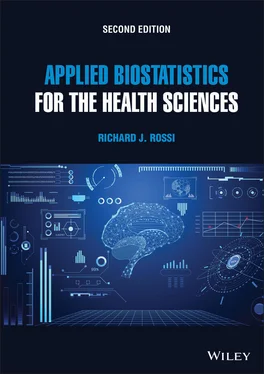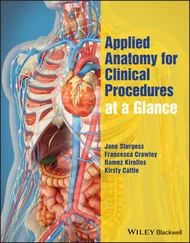Richard J. Rossi - Applied Biostatistics for the Health Sciences
Здесь есть возможность читать онлайн «Richard J. Rossi - Applied Biostatistics for the Health Sciences» — ознакомительный отрывок электронной книги совершенно бесплатно, а после прочтения отрывка купить полную версию. В некоторых случаях можно слушать аудио, скачать через торрент в формате fb2 и присутствует краткое содержание. Жанр: unrecognised, на английском языке. Описание произведения, (предисловие) а так же отзывы посетителей доступны на портале библиотеки ЛибКат.
- Название:Applied Biostatistics for the Health Sciences
- Автор:
- Жанр:
- Год:неизвестен
- ISBN:нет данных
- Рейтинг книги:3 / 5. Голосов: 1
-
Избранное:Добавить в избранное
- Отзывы:
-
Ваша оценка:
- 60
- 1
- 2
- 3
- 4
- 5
Applied Biostatistics for the Health Sciences: краткое содержание, описание и аннотация
Предлагаем к чтению аннотацию, описание, краткое содержание или предисловие (зависит от того, что написал сам автор книги «Applied Biostatistics for the Health Sciences»). Если вы не нашли необходимую информацию о книге — напишите в комментариях, мы постараемся отыскать её.
APPLIED BIOSTATISTICS FOR THE HEALTH SCIENCES Applied Biostatistics for the Health Sciences
Applied Biostatistics for the Health Sciences
Applied Biostatistics for the Health Sciences — читать онлайн ознакомительный отрывок
Ниже представлен текст книги, разбитый по страницам. Система сохранения места последней прочитанной страницы, позволяет с удобством читать онлайн бесплатно книгу «Applied Biostatistics for the Health Sciences», без необходимости каждый раз заново искать на чём Вы остановились. Поставьте закладку, и сможете в любой момент перейти на страницу, на которой закончили чтение.
Интервал:
Закладка:
Diagnostic trials that are clinical trials designed to determine tests or procedures that can be used for diagnosing a particular disease or condition.
Quality-of-life trials that are clinical trials designed to explore ways to improve the comfort and quality of life for individuals with a chronic or terminal disease or condition.
Genetic trials that are clinical trials designed to investigate the role genetics plays in the detection, diagnosis, or response to a drug or treatment.
Pharmaceutical companies commonly use treatment trials in the development and evaluation of new drugs, epidemiologists generally use prevention, screening, and diagnostic trials in their studies of diseases, public health officials often use quality-of-life trials, and geneticists often use genetic trials for studying tissue or blood samples from families or large groups of people to understand the role of genes in the development of a disease.
The results of a clinical trial are generally published in peer-reviewed scientific or medical journals. The peer-review process is carried out by experts who critically review a research report before it is published. In particular, the peer reviewers are charged with examining the research protocol, analysis, and conclusions drawn in a research report to ensure the integrity and quality of the research that is published. Following the publication of the results of a clinical trial or biomedical research study, further information is generally obtained as new studies are carried out independently by other researchers. The follow-up research is generally designed to validate or expand the previously published results.
1.3.3 The Phases of a Clinical Trial
Clinical research is often conducted in a series of steps, called phases. Because a new drug, medicine, or treatment must be safe, effective, and manufactured at a consistent quality, a series of rigorous clinical trials are usually required before the drug, medicine, or treatment can be made available to the general public. In the United States the FDA regulates and oversees the testing and approval of new drugs as well as dietary supplements, cosmetics, medical devices, blood products, and the content of health claims on food labels. The approval of a new drug by the FDA requires extensive testing and evaluation of the drug through a series of four clinical trials, which are referred to as phase I , II , III , and IV trials.
Each of the four phases is designed with a different purpose and to provide the necessary information to help biomedical researchers answer several different questions about a new drug, treatment, or biomedical procedure. After a clinical trial is completed, the researchers use biostatistical methods to analyze the data collected during the trial and make decisions and draw conclusions about the meaning of their findings and whether further studies are needed. After each phase in the study of a new drug or treatment, the research team must decide whether to proceed to the next phase or stop the investigation of the drug/treatment. Formal approval of a new drug or biomedical procedure generally cannot be made until a phase III trial is completed and there is strong evidence that the drug/treatment is safe and effective.
The purpose of a phase I clinical trial is to investigate the safety, efficacy, and side effects of a new drug or treatment. Phase I trials usually involve a small number of subjects and take place at a single or only a few different locations. In a drug trial, the goal of a phase I trial is often to investigate the metabolic and pharmacologic actions of the drug, the efficacy of the drug, and the side effects associated with different dosages of the drug. Phase I drug trials are also referred to as dose finding trials .
When the results of a phase I trial suggest that a treatment or drug appears to have promise, the treatment or drug is generally next studied in a phase II trial. In phase II clinical trials, the drug or treatment being studied is evaluated on a larger group of subjects to further investigate its effectiveness and safety. In general, the goal of a phase II trial is to study the feasibility and level of activity of the drug or treatment. Thus, phase II trials are designed to provide more information about the effective dosage of a drug, the severity of the side effects, and how to manage the side effects. Phase II trials are also referred to as safety and efficacy trials and usually involve more subjects than phase I trials.
When the preliminary results of a new drug or treatment from a phase II trial suggest the drug or treatment will be effective and safe, a phase III trial is designed to gather additional information that can be used in evaluating the overall benefit–risk relationship of the drug. Phase III trials are usually designed to compare the new drug/treatment with standard or commonly used drugs/treatments, to confirm its effectiveness, to further monitor side effects, and to determine how the new drug or treatment can be safely used. Phase III trials generally are large trials and may enroll subjects at a wide variety of locations. Phase III trials are also referred to as comparative treatment efficacy trials .
Finally, when a new drug or treatment has been examined in phase I, II, and III trials and has been approved for the general public, a phase IV trial is usually initiated. A phase IV trial is a postmarketing study designed to obtain additional information on the risks associated with the drug/treatment, its benefits, and its optimal use. The primary aim of a phase IV trial is to evaluate the long-term safety and effectiveness of a drug/treatment. Phase IV trials sometimes result in a drug being taken completely off the market or new restrictions being placed on the use of the drug. Phase IV trials are also referred to as expanded safety trials and usually involve a very large number of subjects.
Note that the number of subjects in a trial usually increases as the phases of the study progress. That is, a phase I trial usually involves fewer subjects than a phase II trial, a phase II trial usually involves fewer subjects than a phase III trial, and a phase III trial usually involves fewer subjects than a phase IV trial. Also, some research studies involving human subjects will have less than four phases. For example, it is not unusual for screening, prevention, diagnostic, genetic, and quality-of-life studies to be conducted in only phase I or II trials. However, new drugs and biomedical procedures almost always require phase I, II, and III clinical trials for approval and a phase IV trial to track the safety of the drug after its approval. The development of a new drug may take many years to proceed through the first three phases of the approval process, and following approval, the phase IV trial usually extends over a period of many years.
1.4 Data Set Descriptions
Throughout this book several data sets will be used in the examples and exercises. These data sets are available at www.mtech.edu/math/faculty/rick-rossi/Book-Rossi.htmlas Excel files and MINITAB worksheets; web addresses frequently change at Montana Tech, searching for Rick Rossi on the Montana Tech web page will also allow you to find the data sets on my personal web page.
Permission to use the Birth Weight, Intensive Care Unit, Coronary Heart Disease, UMASS Aids Research Unit, and Prostate Cancer data sets has been granted by John Wiley & Sons, Inc. These data sets were first published in Applied Logistic Regression (Hosmer, 2000). Permission to use the Body Fat data set has been provided by Roger W. Johnson, Department of Mathematics & Computer Science, South Dakota School of Mines & Technology and the Journal of Statistics Education.
Читать дальшеИнтервал:
Закладка:
Похожие книги на «Applied Biostatistics for the Health Sciences»
Представляем Вашему вниманию похожие книги на «Applied Biostatistics for the Health Sciences» списком для выбора. Мы отобрали схожую по названию и смыслу литературу в надежде предоставить читателям больше вариантов отыскать новые, интересные, ещё непрочитанные произведения.
Обсуждение, отзывы о книге «Applied Biostatistics for the Health Sciences» и просто собственные мнения читателей. Оставьте ваши комментарии, напишите, что Вы думаете о произведении, его смысле или главных героях. Укажите что конкретно понравилось, а что нет, и почему Вы так считаете.












